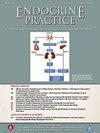原发性醛固酮增多症的PET/CT分类:18-oxocortisol和68ga - pentxa8。
IF 3.7
3区 医学
Q2 ENDOCRINOLOGY & METABOLISM
引用次数: 0
摘要
目的:探讨原发性醛固酮增多症(PA)分型的无创准确评价方法。方法:选取99例醛固酮生成性腺瘤(APA)患者和61例特发性醛固酮增多症(IHA)患者作为研究对象。在该队列中进行了液相色谱-串联质谱(LC-MS/MS)和68ga - pentxafor PET/CT。采用统计学方法计算单、双方法的诊断效率。结果:在LC-MS/MS检测类固醇谱中,APA组除醛固酮外的6种类固醇平均水平均高于IHA组。18-羟皮质醇的鉴别诊断效率(临界值为0.132 ng/mL)高于其他类固醇,敏感性为75.3%,特异性为91.2%。对于68ga - pentxapet /CT,目视分析灵敏度为93.7%,特异度为56.3%。在最佳SUVmax为8.00时,敏感性为69.8%,特异性为93.7%。考虑到18-羟皮质激素水平和68ga - pentxafor PET/CT SUVmax, 100%双阳性结果的患者被归为正确的APA亚型。如果结合18-羟皮质激素水平和68ga - pentxafor PET/CT视觉分析进行PA亚型分型,至少一个阳性的敏感性为95.2%,总共87.2%的患者可以正确分类。结论:LC-MS/MS和68ga - pentxafor PET/CT对PA的分型有较大优势。两种方法的结合具有较高的准确性,有助于避免大多数PA患者术前不必要的AVS手术。本文章由计算机程序翻译,如有差异,请以英文原文为准。
Primary Aldosteronism Classification With 18-Oxocortisol and Gallium-68–Pentixafor Positron Emission Tomography/Computed Tomography
Objective
This study aimed to explore the noninvasive and accurate evaluation methods of primary aldosteronism (PA) classification.
Methods
There were 99 patients with aldosterone-producing adenoma (APA) and 61 with idiopathic hyperaldosteronism recruited in this study. Liquid chromatography-tandem mass spectrometry (LC-MS/MS) and gallium-68 (68Ga)–pentixafor positron emission tomography (PET)/computed tomography (CT) were performed in this cohort. Statistical analysis was used to calculate the diagnostic efficiency of single or double methods.
Results
In steroid profiling detected by LC-MS/MS, the average levels of 6 steroids apart from aldosterone in the APA group were higher than those in the idiopathic hyperaldosteronism group. The differential diagnostic efficiency of 18-oxocortisol (cutoff value at 0.132 ng/mL) was greater than other steroids, with a sensitivity of 75.3% and specificity of 91.2%. As for 68Ga-pentixafor PET/CT, visual analysis showed a sensitivity of 93.7% and specificity of 56.3%. At the optimum maximum standardized uptake value of 8.00, the sensitivity was 69.8%, and the specificity was 93.7%. Taking into account the 18-oxocortisol level and 68Ga-pentixafor PET/CT maximum standardized uptake value, 100% of patients with double positive results were placed in the right APA subtype. If the 18-oxocortisol level with 68Ga-pentixafor PET/CT visual analysis was combined for PA subtyping, the sensitivity of at least 1 positive was 95.2%, and a total of 87.2% of patients could be classified correctly.
Conclusion
The LC-MS/MS and 68Ga-pentixafor PET/CT have great advantages on the subtyping of PA. There was a high accuracy of the combination of the 2 methods, which will contribute to avoid an unnecessary adrenal venous sampling operation before surgery for most patients with PA.
求助全文
通过发布文献求助,成功后即可免费获取论文全文。
去求助
来源期刊

Endocrine Practice
ENDOCRINOLOGY & METABOLISM-
CiteScore
7.60
自引率
2.40%
发文量
546
审稿时长
41 days
期刊介绍:
Endocrine Practice (ISSN: 1530-891X), a peer-reviewed journal published twelve times a year, is the official journal of the American Association of Clinical Endocrinologists (AACE). The primary mission of Endocrine Practice is to enhance the health care of patients with endocrine diseases through continuing education of practicing endocrinologists.
 求助内容:
求助内容: 应助结果提醒方式:
应助结果提醒方式:


